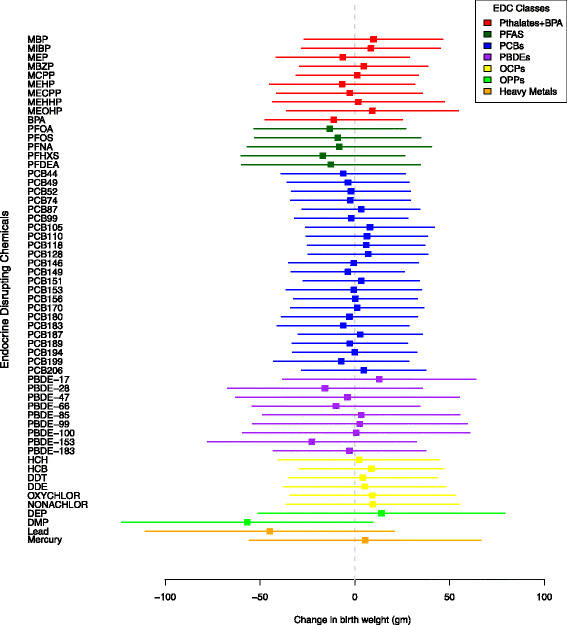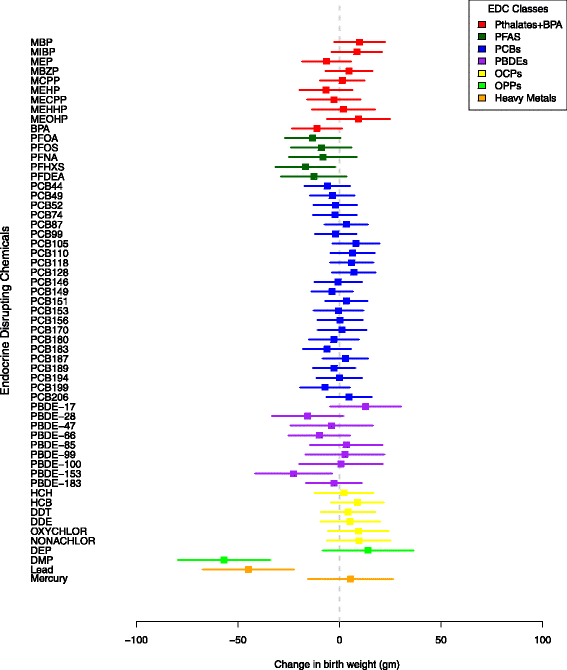Gestational exposure to endocrine disrupting chemicals in relation to infant birth weight: a Bayesian analysis of the HOME Study
- PMID: 29078782
- PMCID: PMC5658906
- DOI: 10.1186/s12940-017-0332-3
Gestational exposure to endocrine disrupting chemicals in relation to infant birth weight: a Bayesian analysis of the HOME Study
Abstract
Background: Pregnant women are exposed to a mixture of endocrine disrupting chemicals (EDCs). Gestational EDC exposures may be associated with changes in fetal growth that elevates the risk for poor health later in life, but few studies have examined the health effects of simultaneous exposure to multiple chemicals. This study aimed to examine the association of gestational exposure to five chemical classes of potential EDCs: phthalates and bisphenol A, perfluoroalkyl substances (PFAS), polychlorinated biphenyls (PCBs), polybrominated diphenyl ethers (PBDEs), and organochlorine pesticides (OCPs) with infant birth weight.
Methods: Using data from the Health Outcomes and Measures of Environment (HOME) Study, we examined 272 pregnant women enrolled between 2003-2006. EDC concentrations were quantified in blood and urine samples collected at 16 and 26 weeks gestation. We used Bayesian Hierarchical Linear Models (BHLM) to examine the associations between newborn birth weight and 53 EDCs, 2 organochlorine pesticides (OPPs) and 2 heavy metals.
Results: For a 10-fold increase in chemical concentration, the mean differences in birth weights (95% credible intervals (CI)) were 1 g (-20, 23) for phthalates, -11 g (-52, 34) for PFAS, 0.2 g (-9, 10) for PCBs, -4 g (-30, 22) for PBDEs, and 7 g (-25, 40) for OCPs.
Conclusion: Gestational exposure to phthalates, PFAS, PCBs, PBDEs, OCPs or OPPs had null or small associations with birth weight. Gestational OPP, Pb, and PFAS exposures were most strongly associated with lower birth weight.
Keywords: Birth weight; Endocrine disruptors; Environmental exposure; Maternal exposure; Pregnancy.
Conflict of interest statement
Ethics approval and consent to participate
The Institutional Review Boards (IRBs) of Cincinnati Children’s Hospital Medical Center (CCHMC) and participating delivery hospitals approved the HOME Study. After research assistants explained study protocols, all women provided written informed consent for themselves and their children.
Consent for publication
Not applicable.
Competing interests
The authors declare that they have no competing interests.
Publisher’s Note
Springer Nature remains neutral with regard to jurisdictional claims in published maps and institutional affiliations.
Figures
References
-
- Ryu MH, Jha A, Ojo OO, Mahood TH, Basu S, Detillieux KA, Nikoobakht N, Wong CS, Loewen M, Becker AB, Halayko AJ. Chronic exposure to perfluorinated compounds: impact on airway hyper-responsiveness and inflammation. Am J Physiol Lung Cell Mol Physiol. 2014;307:L765–L774. doi: 10.1152/ajplung.00100.2014. - DOI - PMC - PubMed
Publication types
MeSH terms
Substances
Grants and funding
LinkOut - more resources
Full Text Sources
Other Literature Sources
Medical



